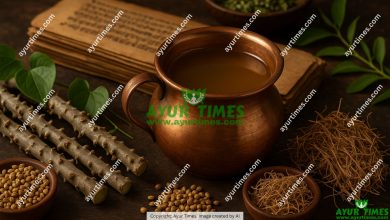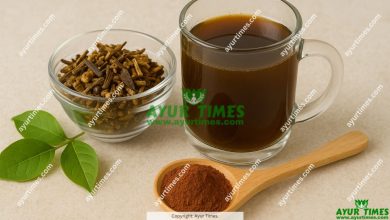Pathyadi Kadha
Pathyadi Kadha is an Ayurvedic medicine mainly used for diseases of the head and nervous system. It is a classical formulation commonly prescribed for chronic headaches, migraines, and various types of Shiro Roga (head disorders).
Pathyadi Kadha Ingredients
| Ingredients | Quantity |
|---|---|
| Haritaki (Terminalia chebula) | 1 Tola |
| Bibhitaki (Terminalia bellirica) | 1 Tola |
| Amalaki (Emblica officinalis) | 1 Tola |
| Chirayata (Swertia chirata) | 1 Tola |
| Turmeric (Curcuma longa) | 1 Tola |
| Neem leaves (Azadirachta indica) | 1 Tola |
| Giloy (Tinospora cordifolia) | 1 Tola |
| Jaggery (Guda) | 6 Tola |
| Dhawai flowers (Woodfordia fruticosa) | 10 Flowers |
Pharmacological Actions
Ingredients in Pathyadi Kadha pacify Vata and Pitta aggravation and act as anti-inflammatory, antipyretic, detoxifying, nervine and analgesic agents.
Pathyadi Kadha pacifies Vata and Pitta Dosha and acts as a nervine tonic, neuroprotective, analgesic, anti-inflammatory, anti-arthritic, and detoxifying formulation.
It supports the treatment of a wide spectrum of head and nerve disorders. It reduces pain, clears toxins, and strengthens the nervous system.
Medicinal Properties
- Nervine Tonic
- Neuroprotective
- Anti-paralytic
- Anti-rheumatic
- Anti-inflammatory
- Analgesic
- Detoxifier
- Adaptogenic
- Antioxidant
- Antispasmodic
- Alterative
- Antinociceptive
- Mild Laxative
Ayurvedic Properties
| Property Type | Description |
|---|---|
| DOSHA KARMA | Pacifies Vata and Pitta Dosha |
| Dhatu (Tissue) Effect | RASA, RAKTA, MAMSA, ASTHI |
| Organs Effect | Nerves, Muscles, Bones, Head |
| Main Indication | Chronic Headache, Migraines, Shira Roga |
| RASA (Taste) | Tikta (Bitter), Kashaya (Astringent) |
| ANU RASA (After Taste) | Kashaya (Astringent) |
| GUNA (Main Quality) | Laghu (Light), Ruksha (Dry), Tikshna (Sharp) |
| VIRYA (Potency) | Ushna (Hot) |
| VIPAKA (Resultant Taste) | Katu (Pungent) |
| PRABHAVA (Specific Action) | Shiro-Roga Nashaka (Relieves head disorder |
Thapeutic Indications
Pathyadi Kadha is indicated in the following conditions:
- Suryaavarta (Sun-induced headache)
- Ardhavabhedaka (Migraine)
- Anantavaata
- Chronic Headache
- Neuralgic pain
- Vata-Pitta Head Disorders
- Detoxification in Shira-Roga (head region)
Benefits & Medicinal Uses
Suryaavarta (Sun-Induced Headache)
Suryaavarta is a Pitta-dominant headache that worsens with sunlight exposure. Pathyadi Kadha’s Pitta-pacifying herbs like Neem, Chirayata, and Amalaki cool the system and reduce the burning sensation. It also calms Vata, which contributes to the pulsating nature of the pain.
Recommended Symptoms:
- Headache that worsens after sunrise and peaks by mid-day
- Burning or heat sensation in forehead
- Light sensitivity
- Associated irritability or eye discomfort
Avoid In:
- If patient has Pitta-dominant ulcers or gastritis, use cautiously
- Avoid combining with hot, spicy foods
Dosage:
- 30 ml twice daily before food
- Take with cool water or Shatavari decoction
Herbal Combinations:
- Combine with Amritarishta in case of associated low-grade fever
- Use with Brahmi Syrup to soothe the nervous system
Ardhavabhedaka (Migraine)
Ardhavabhedaka is often one-sided, piercing and linked with both Vata and Pitta imbalance. Pathyadi Kadha works by regulating cerebral blood flow, reducing inflammation, and calming nerve hyperexcitability. The fermentation process also supports gut health, indirectly balancing brain function.
Recommended Symptoms:
- One-sided headache with aura
- Nausea, vomiting, or photophobia
- Pulsating or pricking sensation
- Triggered by stress, fasting, menstruation
Avoid In:
- Very weak digestion or extreme fatigue (start with smaller doses)
- Pregnancy – unless supervised
Dosage:
- 30 ml twice a day with lukewarm water
- Continue for at least 2 months for chronic migraine relief
Herbal Combinations:
- Combine with Saraswatarishta or Kalyanaka Ghrita
- For hormonal migraine, use Ashokarishta or Shatavari Kalpa under guidance
Anantavaata
Anantavaata refers to pain in the neck, shoulder, and head region due to aggravated Vata in the nervous system. Pathyadi Kadha helps by nourishing Majja Dhatu (nerve tissue), lubricating the joints, and reducing nerve stiffness.
Recommended Symptoms:
- Radiating pain from neck to scalp
- Stiffness or muscle cramps
- Headaches linked with neck fatigue
- Dryness in body or constipation
Avoid In:
- Acute fevers or Ama accumulation—use only after Ama is cleared
- Severe dryness (may need ghee-based Rasayanas along with it)
Dosage:
- 30 ml with Dashamoola Kwatha for deeper Vata correction
- Continue for 2–3 months for lasting results
Herbal Combinations:
- Maha Rasnadi Kwath for joint pain
- Ashwagandha Churna or Bala Taila externally for strengthening
Chronic Headache
Pathyadi Kadha detoxifies accumulated metabolic waste (Ama), strengthens the nervous system, and prevents recurrent head pain. It works slowly but deeply by correcting the root cause in Vata and Pitta derangement.
Recommended Symptoms:
- Persistent dull ache in forehead or occipital region
- Recurring headaches not linked to specific triggers
- Tiredness, poor sleep, heaviness in head
Avoid In:
- Active ulcers or Pitta aggravation symptoms—cool the system first
- Individuals with extreme Kapha dominance may need supportive herbs
Dosage:
- 30–60 ml twice daily for at least 2–3 months
- Should be taken before food for best effect
Herbal Combinations:
- Draksharishta for patients with fatigue or anemia
- Chitrakadi Vati in low Agni conditions
Neuralgic Pain
Neuralgic pains are sharp, shooting pains linked with Vata aggravation in nerve pathways. Pathyadi Kadha reduces nerve inflammation and relieves spasms. Giloy and Haritaki act as nervine tonics and improve coordination in nerve impulses.
Recommended Symptoms:
- Sudden electric-shock like pain in face or neck
- Nerve sensitivity and tingling
- Associated coldness or dryness
Avoid In:
- Pregnancy
- Severe anxiety or insomnia (use with sedative herbs)
Dosage:
- 30 ml twice daily before meals
- Combine with warming oils externally (e.g., Mahanarayan Taila)
Herbal Combinations:
- Ashwagandharishta or Bala Ashwagandhadi Taila externally
- Yograj Guggulu for deeper tissue support
Vata-Pitta Head Disorders
This formulation is ideal for mixed-type headaches—where Vata causes variability and dryness, and Pitta adds intensity and heat. Pathyadi Kadha balances both through its Tikta (bitter) rasa and Ushna (hot potency).
Recommended Symptoms:
- Headaches with mental restlessness
- Insomnia, dizziness, irritability
- Dry eyes, scalp sensitivity
Avoid In:
- Kapha dominance with heaviness and sinus congestion—use Trikatu alongside
- Ulcerative conditions—combine cautiously with cooling herbs
Dosage:
- 30–60 ml twice a day
- Best taken with lukewarm water
Herbal Combinations:
- Combine with Brahmi Ghrita for mental clarity
- Add Sutshekhar Ras in acute burning headache
Detoxification in Shira-Roga (Head Region Disorders)
Pathyadi Kadha eliminates Ama (toxins), clears obstructed channels (Srotas), and purifies blood (Rakta Shodhana). Ingredients like Neem and Chirayata have strong antimicrobial and blood-detox properties.
Recommended Symptoms:
- Dullness, heaviness, or mental fog
- Skin issues on scalp or forehead
- Scalp swelling or mild infections
- Post-viral headaches or long COVID-type symptoms
Avoid In:
- Debilitated or emaciated patients—combine with nourishing Rasayanas
- Children under 7 without professional advice
Dosage:
- 30 ml twice daily before food
- Continue for at least 3 weeks in detox programs
Herbal Combinations:
- Mahamanjishtadi Kwath for skin and blood purification
- Triphala Churna at night to support elimination
Dosage & Administration
Pathyadi Kadha is available in three forms:
- Pathyadi Kadha Churna
- Pathyadi Kadha Liquid
- Pathyadi Kadha Tablets
Pathyadi Kadha Churna
| Age Group | Dosage |
|---|---|
| Children | 15 to 30 ml * |
| Adults | 30 to 60 ml * |
| Maximum | 120 ml/day (divided doses) |
*Preparation: 60 gm churna in 960 ml water, boiled and reduced to 120 ml.
Best Time to Take: Before food.
Pathyadi Kadha Liquid (Ready-made)
| Age Group | Dosage |
|---|---|
| Children | 2.5 to 10 ml * |
| Adults | 5 to 15 ml * |
| Maximum | 30 ml/day (divided doses) |
*Take with 4x boiled and cooled water.
Best Time: Before food.
Pathyadi Kadha Tablets
| Age Group | Dosage |
|---|---|
| Children | 1 tablet * |
| Adults | 2 tablets * |
| Maximum | 4 tablets/day (divided doses) |
*Twice daily with warm water.
Note: Based on 1000 mg tablets.
Best Time: 30 minutes before food.
Adjuvants
- Warm water
- Dashamoolarishta or Draksharishta (as advised by physician)
Safety Profile
All forms of Pathyadi Kadha are safe and well-tolerated when taken under the supervision of an Ayurvedic physician. Best suited for individuals with Vata-Pitta dominant conditions.
Side Effects
No adverse effects have been reported. In rare cases, mild dryness may occur due to the dry nature of some ingredients.
Pregnancy & Lactation
- Pregnancy: Use with caution; consult an Ayurvedic doctor.
- Lactation: Likely safe; no adverse effects reported on mother or child.


